Lithium-ion batteries have become the standard in the electrification revolution, powering everything from electric vehicles to portable electronic devices. However, the extraction of lithium and other materials used in these batteries is costly, time-consuming, and harmful to the environment. In an effort to create more efficient and eco-friendly batteries, several startups have emerged, experimenting with different chemistries and materials.
Key Takeaway
Singapore-based startup Flint has developed paper batteries that eliminate the need for lithium, nickel, and cobalt. By using zinc, manganese, and cellulose papers, Flint aims to create batteries that are more sustainable and safer than traditional lithium-ion batteries. While Flint’s paper batteries still need improvements in energy density and lifecycle, they offer a viable option for manufacturers and suppliers looking to transition to greener battery alternatives.
Introducing Flint’s Revolutionary Paper Batteries
Singapore-based startup, Flint, is one such company that aims to revolutionize the battery industry with its innovative paper batteries. Instead of relying on lithium, nickel, and cobalt, Flint uses zinc, manganese, and cellulose papers as the key components of its batteries. By doing so, the company claims to have found a way to maintain the battery’s manufacturing process while offering improved performance and sustainability.
Flint’s paper batteries consist of a zinc-based anode, a manganese-based cathode, and a paper separator. The cellulose paper, anode, and cathode are coated in a hydrogel and then baked in a vacuum oven, creating a hydrogel-reinforced cellulose paper. This hydrogel, Flint’s secret sauce, facilitates electron transfer between the anode and cathode, eliminating the need for a separate separator and electrolyte.
While Flint’s battery achieves a different chemical makeup, it retains the same structure and manufacturing process as traditional lithium-ion batteries. This allows for easy integration into existing production lines, making it a viable option for manufacturers and suppliers looking to switch to more sustainable battery alternatives.
The Advantages of Flint’s Paper Batteries
Flint’s choice of zinc and manganese over lithium, cobalt, and nickel offers numerous advantages. Firstly, zinc and manganese are more abundant materials, addressing concerns about the sustainability of lithium battery production. Secondly, they are safer materials, reducing the risk of battery fires and explosions. Flint’s batteries have demonstrated the ability to continue functioning even if cut during operation, highlighting their enhanced safety features.
The temperature range at which Flint’s paper batteries operate is also noteworthy. Unlike traditional batteries, which typically work between 15°C and 35°C, Flint’s batteries can function in temperatures ranging from -15°C to 80°C. This expanded operating range opens up opportunities for a wider range of applications and ensures efficiency is maintained over time.
The Path to Commercialization
While Flint’s paper batteries show promise in terms of cost and safety, they still have room for improvement. Currently, Flint can only provide approximately 60% to 70% of the energy density of a lithium battery when rolled up into a standard AA battery size. However, the company is actively working on increasing this number to match or surpass lithium batteries. In the meantime, Flint is exploring applications where energy density is less critical.
Furthermore, Flint acknowledges the need to improve the lifecycle of its batteries before they can be launched into the market. Extensive testing has shown that after 1,000 lifecycles, Flint’s battery maintains 70% of its initial health. While this falls short of the lifespan of a well-tested lithium battery, Flint remains determined to refine their batteries and tackle this challenge.
Conclusion: Redefining Battery Technology with Paper
Flint’s journey to disrupt the battery industry with its paper batteries has not been without its obstacles. However, the startup’s limited resources have not deterred its progress. With financial support from the Singapore government and a determined team of five staff members and four advisors, Flint has made significant strides in developing and testing its paper batteries.
The future is promising for Flint as it nears the optimization of its battery’s chemistry and seeks partnerships with companies interested in incorporating its paper batteries in their products. Whether it’s energy storage systems, remote sensors and wearables, or even electric vehicles, Flint aims to provide a more sustainable and efficient alternative to traditional lithium-ion batteries.

























